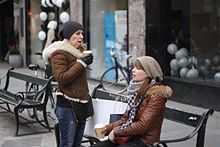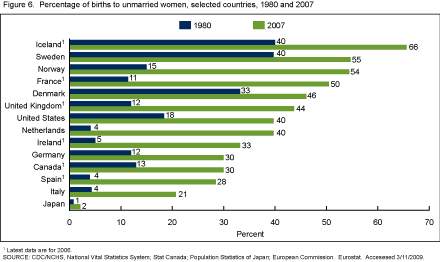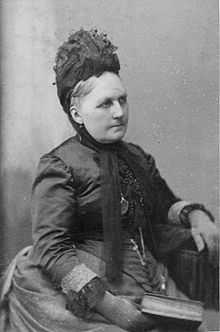Women in Denmark
 Two Danish women having a cup of coffee in Copenhagen, Denmark Feb. 2014. | |
| Gender Inequality Index[1] | |
|---|---|
| Value | 0.056 (2013) |
| Rank | 5th out of 152 |
| Maternal mortality (per 100,000) | 12 (2010) |
| Women in parliament | 39.1% (2013) |
| Females over 25 with secondary education | 95.5% (2012) |
| Women in labour force | 59.1% (2012) |
| Global Gender Gap Index[2] | |
| Value | 0.7779 (2013) |
| Rank | 8th out of 136 |
The modern-day character and the historical status of women in Denmark has been influenced by their own involvement in women's movements and political participation in the history of Denmark. Their mark can be seen in the fields of politics, women's suffrage, and literature, among others.
Women's movement
There had been two major periods of women's movement in Denmark. The first one was from 1870 to 1920. The second was from 1970 to 1985.
The first women's movement was led by the Dansk Kvindesamfund ("Danish Women's Society"). Line Luplau was one of the most notable woman in this era. Tagea Brandt was also part of this movement, and in her honor was stablished Tagea Brandt Rejselegat or Travel Scholarship for women. The Dansk Kvindesamfund's efforts as a leading group of women for women led to the existence of the revised Danish constitution of 1915, giving women the right to vote and the provision of equal opportunity laws during the 1920s, which influenced the present-day legislative measures to grant women access to education, work, marital rights and other obligations.[3]
The second wave of women's movement was organized with the Rødstrømpebevælgelsen (the Red Stocking movement). The effort led to "institutionalized feminism" (managed directly by the Danish government) and to the "mainstreaming of equal opportunities" between Danish men and women.[3]
Women's suffrage
Women in Denmark gained the right to vote on 05 June 1915.[4]
Parliamentary appointments and elections
.jpg)
In 1918, a total of twelve Danish women were elected to the Danish parliament. Four of those women were elected to the Lower House (known as the Folketinget), while eight Danish women were elected to the Upper House (known as the Landstinget). In 1924, Nina Bang became the first female minister of Denmark, making Denmark the second country in the world to have a female minister.[5] Jytte Anderson served as Minister of Employment from 1993 to 1998. Anderson was later appointed in 1998 as Senior Minister for Construction and Housing. In 1999, Andersen was appointed as the first Danish Minister on Gender Equality in 1999.[5]
A second female minister in Denmark was elected twenty years later (counting from 1924). Afterwards - in 2000 - the female members of the government of Denmark increased to 45%.[5]
Family life

As in many other Western countries, the connection between fertility and marriage has been significantly weakened in the past decades. As of 2013, 51.5% of births were to unmarried women.[7] Denmark was one of the first European countries to change its social norms towards unmarried cohabitation and childbearing, at a time where this was still seen as unacceptable in many other parts of the continent.
Reproductive rights and sexuality
The maternal mortality rate in Denmark is 12 deaths/100,000 live births (as of 2010).[8] Although this is low by international standards, it is higher than in many other Western countries, and it has increased in recent years.[9]
Abortion laws were liberalized in 1973, allowing the procedure to be done on-demand during the first 12 weeks, and in specific circumstances at later stages of the pregnancy.[10]
Denmark's HIV/AIDS rate is 0.2% of adults (aged 15-49) - estimates of 2009.[11]
The total fertility rate (TFR) in Denmark is 1.73 children born/woman (2014 estimates), which, although below the replacement rate, is one of the highest in Europe.[12]
Denmark provides for sex education in schools.[13] The age of consent in Denmark is 15.
Denmark has a reputation of being "open" with regards to sexuality, perhaps due to historical factors, such as being the first country to abolish censorship and legalize pornography in 1967. However, today the Danish pornography industry is minimal compared to many other countries, with large scale production of pornography having moved to other countries.[14]
Violence against women
The issues of violence against women and domestic violence are controversial;[15][16] according to a 2014 study published by the European Union Agency for Fundamental Rights, Denmark had the highest prevalence rate of physical and sexual violence against women in Europe.[17][18] Denmark has also received harsh criticism for inadequate laws in regard to sexual violence in a 2008 report produced by Amnesty International,[19] which has described Danish laws as "inconsistent with international human rights standards",[20] which has led to Denmark eventually reforming its sexual offenses legislation in 2013.[21][22][23] Denmark has also ratified the Convention on preventing and combating violence against women and domestic violence.[24] A 2010 Eurobarometer poll on violence against women found that victim blaming attitudes are common in Denmark: 71% of Danes agreed with the assertion that the "provocative behaviour of women" was a cause of violence against women, well above the 52% European average.[25]
Notable Danish women
Suffrage and politics

Among notable female Danes was Mathilde Bajer, who - together with her husband Fredrik Bajer - founded the Danish Women's Society in 1871, the oldest women's rights organization in the world. Another notable Danish woman was Lise Nørgaard (b. 1917), a Danish author and journalist during the 1930s and the 1940s. She authored the autobiographical books such as the Kun en pige ("Just a Girl", 1992) and De sendte en dame ("They Sent a Lady", 1993).[3] Another notable Danish woman was Line Luplau, who achieved national fame in 1887 when she supported the cause to grant women to vote during local elections.[4]
Literature
In literature, one of the most notable female literary writers in Denmark was Karen Blixen (1885–1962). She was also known by the pseudonyms Isak Dinesen and Tania Blixen. Blixen was the author of the Seven Gothic Tales (1934), a collection of short stories, which she wrote at the age of 49.[26]
See also
- List of Danes
- Danish Women's Society
- The Danish Girl, a novel
- Kvindemuseet
- Danish Center for Research on Women and Gender (KVINFO)
References
- ↑ "Table 4: Gender Inequality Index". United Nations Development Programme. Retrieved 7 November 2014.
- ↑ "The Global Gender Gap Report 2013" (PDF). World Economic Forum. pp. 12–13.
- ↑ 3.0 3.1 3.2 Larsen, Jytte. "The women’s movement in Denmark". Translated by Gaye Kynoch. KVINFO. Retrieved 17 November 2013.
- ↑ 4.0 4.1 Nielsen, Jytte. "How Danish women got the vote". translated by Gaye Kynoch. KVINFO. Retrieved 17 November 2013.
- ↑ 5.0 5.1 5.2 Jacobsen, Helle. "Women in Decision-making". Europäische Datenbank: Frauen in Führungspositionen. European Database (2000). Retrieved 17 November 2013.
- ↑ "Changing Patterns of Nonmarital Childbearing in the United States". CDC/National Center for Health Statistics. May 13, 2009. Retrieved September 24, 2011.
- ↑ http://ec.europa.eu/eurostat/tgm/table.do?tab=table&plugin=0&language=en&pcode=tps00018
- ↑ https://www.cia.gov/library/publications/the-world-factbook/rankorder/2223rank.html
- ↑ http://www.injour.com/injour-international/articles/the-rise-and-fall-of-danish-pornography.html
- ↑ http://cyber.law.harvard.edu/population/abortion/Denmark.abo.htm
- ↑ https://www.cia.gov/library/publications/the-world-factbook/rankorder/2155rank.html
- ↑ https://www.cia.gov/library/publications/the-world-factbook/rankorder/2127rank.html
- ↑ http://denmark.angloinfo.com/family/teenagers/teens-sexual-health/
- ↑ http://www.injour.com/injour-international/articles/the-rise-and-fall-of-danish-pornography.html
- ↑ http://kvinfo.org/news-and-background/are-danish-women-most-abused-women-europe
- ↑ http://cphpost.dk/news/danish-women-often-the-victims-of-violence.8782.html
- ↑ "A third of women in EU have suffered 'sexual violence'". France 24. Retrieved 13 October 2014.
- ↑ "Violence against women: an EU-wide survey" (PDF). European Union Agency for Fundamental Rights. pp. 28–30. Retrieved 14 May 2014.
- ↑ http://www.amnesty.dk/sites/default/files/mediafiles/44/case-closed.pdf
- ↑ http://www2.ohchr.org/english/bodies/hrc/docs/ngos/AI_Denmark_November2010.pdf
- ↑ http://www.amnesty.dk/nyhed/amnesty/ny-voldtaegtslovgivning-er-en-sejr-danske-kvinders-retssikkerhed
- ↑ http://www.b.dk/nationalt/slut-med-konerabat-for-voldtaegt
- ↑ https://www.retsinformation.dk/Forms/R0710.aspx?id=164192
- ↑ http://www.conventions.coe.int/Treaty/Commun/ChercheSig.asp?NT=210&CM=&DF=&CL=ENG
- ↑ http://ec.europa.eu/public_opinion/archives/ebs/ebs_344_en.pdf
- ↑ "DANISH LITERATURE". DENMARK (the official website of Denmark), Ministry of Foreign Affairs of Denmark. Retrieved 17 November 2013.
External links
| Wikimedia Commons has media related to Women of Denmark. |
| |||||||||||||||||||||||||||||||||||||||||||||
| ||||||||||||||

